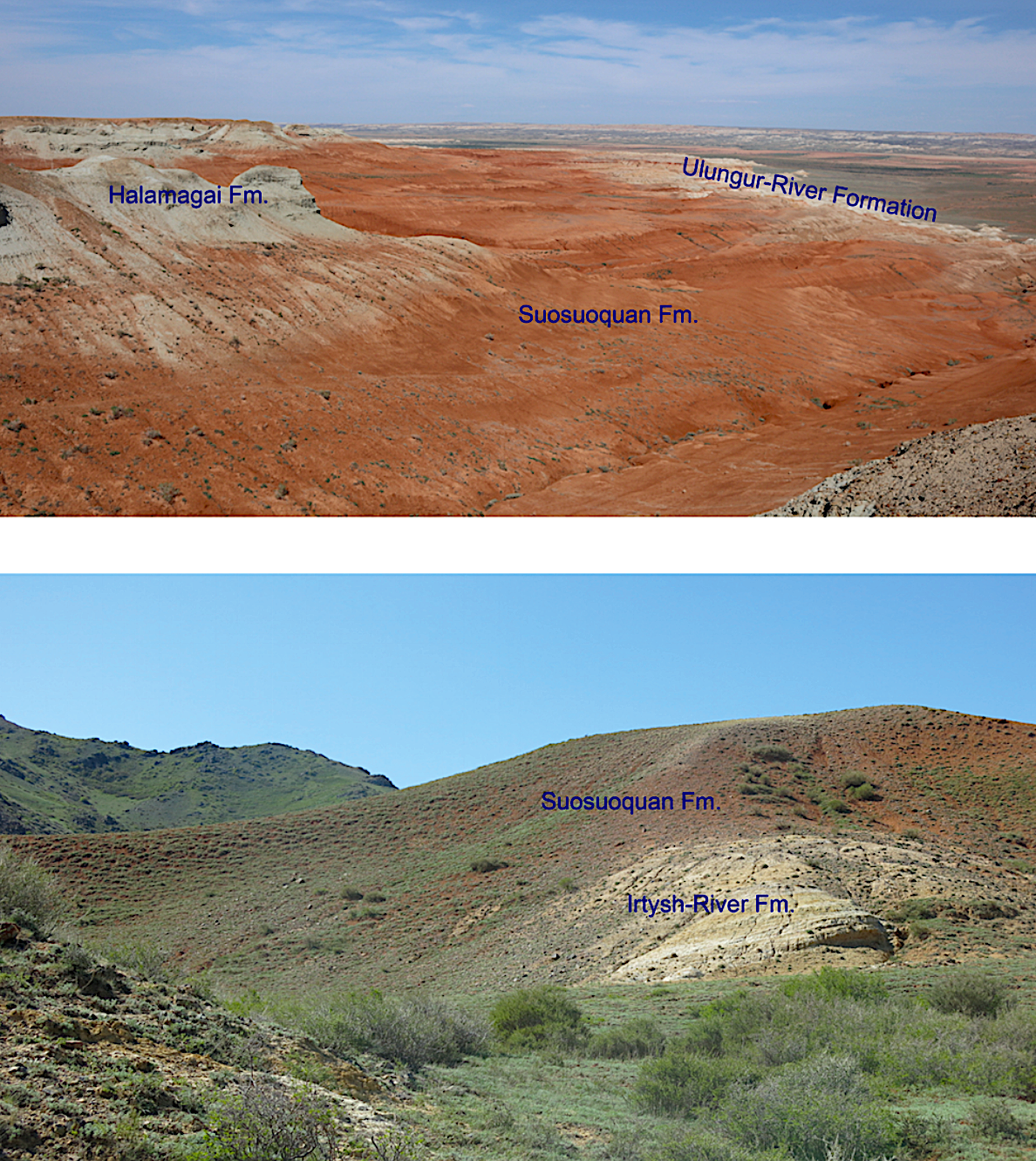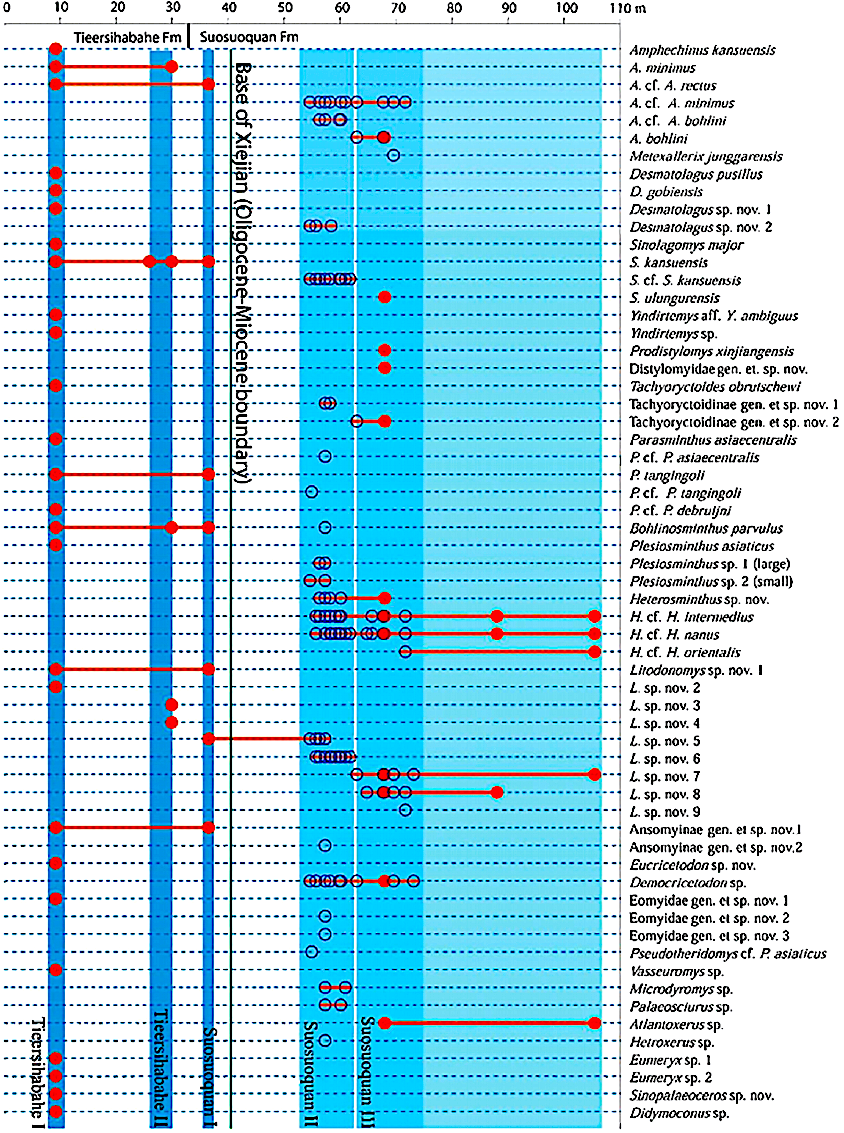Suosuoquan Fm
Type Locality and Naming
Junggar Basin NW. Named by Zhu Xia et al. in 1955 and first used by Pei Wenzhong in 1963. The naming section is located at Chibaerwoyi at the Tieersihabahe Terrance, the north bank of the Ulungur River, Dure Township, Fuyun County. It is 95 km southwest to the Fuyin County, and 83 km southeast to the Fuhai County. Geographical coordinates: 46°39′48.75″N—88°23′56.79″E(GPS) (remeasured by Wang et al., 2019).
[Figure: Geological map of the Tieersihabahe Terrace, showing the naming locality of the Suosuoquan Formation, Chibaerwoyi]
Lithology and Thickness
The Suosuoquan Formation, the most distinctive Tertiary rock unit in the Ulungur Drainage area, is characterized by a set of reddish silt-mudstones that varies little in lithology. It is primarily characterized by the brown silty mudstone and brownish red mudstone, occasionally intercalated with thin-bedded sandstone and conglomerate. Occasionally, it is intercalated by sandy clasts. The Suosuoquan Formation is 61–67 m in thickness at the naming section, 125 m at the Tieersihabahe Section (Zhang et al., 2006).
[Figure: Outcrops of the Suosuoquan Formation. A, the type locality, Chibaerwoyi, showing the superposition of the Suosuoquan, Ulungur-River, and Halamagai formations; B, the Shaerliang outcrop at Jeminay County, the boundary between China and Kazakhstan, indicating the underlying Irtysh-River Fm.]
Relationships and Distribution
Lower contact
The base has a disconformable contact with the underlying Paleogene Yixibaila Fm. It overlaps a variety of strata in different facies and ages. In Jiminay, it directly overlaps the Late Eocene and Early Oligocene Irtysh-River Fm. In the Ulungur River Drainage, the Suosuoquan Formation overlaps the Ulungur-River Fm (Eocene? age) with a considerable hiatus. However, at the Tieersihabahe Section and the Duolebulejin Section, the Suosuoquan Formation is in conformable contact with the underlying Tieersihabahe Fm. In the mountainous areas in the northeast, the formation usually unconformably overlies metamorphic rocks. [NOTE: Tieershibabahe Fm and Ulunguhe Fm spanning Eocene-Oligocene in Deng et al. (2019; China Integrated Strat) are not in provided Cenozoic Lexicon set; so omitted here.]
Upper contact
In the Ulungur River Drainage, the Suosuoquan Formation unconformable underlies the Early-Middle Miocene Halamagai Fm. The disconformable top contact is marked by the appearance of grayish white grit with conglomerate at the base of the overlying Halamagai Fm. Except that at the Duolebulejin Section, they are in conformable contact.
Regional extent
As eolian strata, the Suosuoquan Formation shows an extremely vast distribution across the north of the Junggar Basin, as far east to the Qinghe County, and west to the Jiminay County, almost form the boundary of Mongolia to the boundary of Kazakhstan, ~ 350 km from west to east. The grains in the formation become coarse from west to east. The lithology is dominated by brownish red and grayish green sandstone in the Hongliang area in the west and by pinkish red and grayish green sandstone with occasional mudstone and conglomerate bands and gypsiferous mudstone in the vicinity of Hongpen in the east. Besides its occurrence on the north bank of the Ulungur River, the formation is also found north and south of Delun Mountain (211 m thick), at Kekemaideng (~100 m thick) and at Hongliang (124–156 m thick) and Kalaku’ergou, Hongpen and Dahonggou east of Hongliang (generally 30–50 m thick).
GeoJSON
Fossils
The formation contains mammals such as Prodistylomys xinjiangensis and Sinolagomys ulungurensis. Lower part: Insectivora: Amphechinus bohlini, A. cf. Minimus, Metexallerix junggarensis, Metexallerix sp., Mioechinus? sp., Galerix? sp. Lagomorpha: Sinolagomys ulungurensis, Sinolagomys sp., Bellatona sp., Alloptox sp. Rodentia: Atlantoxerus sp. nov., Palaeosciurus sp. nov., Prodistylomys sp., Tachyoryctoidinae gen. et spp1-2. nov., Cricetodon sp. nov., Parasminthus sp. nov., Litodonomys sp. nov., Litodonomys spp. (A, B, C); Carnivora: Palaeogale cf. Sectoria; Perissodactyla: Aprotodon sp. Artiodactyla: Cervidae gen. et sp. indet. Upper part: Insectivora: Soricidae gen. et sp. indet., Schizogalerix duolebulejinensis Lagomorpha: Sinolagomys ulungurensis, Alloptox gobiensis, Plicalagus junggarensis; Rodentia: Protalactaga shevyrevea, Litodonomys sp. nov., Heterosmintus mongoliensis, Heterosminthus sp. nov., Atlantoxerus sp. Karydomys dzerzhinskii , Cricetodon sp. nov. Sayimys mallos, Atlantoxerus giganteus, Steneofiber depereti, Megacricetodon sp. Carnivora: Thalassictis chinjiensis, Alopecocyon goeriachensis; Artiodactyla: Lagomeryx sp., Eotragus halamagaiensis
[Figure: Stratigraphic ranges of mammals from the Tieersihabahe Fm and Suosuoquan Fm, showing the faunal change across the Oligocene and Miocene boundary
Age
Depositional setting
Eolian deposits, partially reworked by fluvio-lacustrine.
Additional Information


